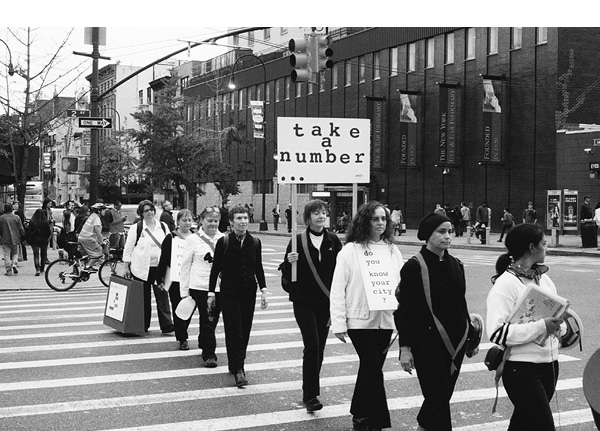
TAKE A NUMBER
first performed on October 11, 2013
Art in Odd Places, New York, NY
performed three times in 2013
VICKY VIRGIN
Marietta Abrams, Tamara Agins, Cynthia Berkshire, Billy Brosh, Danny Brosh, Miguel Cortez, Maja Lorkovic, Lisa Parra, Deon Romrell, Nancy Schwarz, Hayden Spring
New York, NY
987468633v987468633m987468633v987468633i987468633r987468633g987468633i987468633n987468633@987468633g987468633m987468633a987468633i987468633l987468633.987468633c987468633o987468633m
vickyvirgindances.com
TAKE A NUMBER
VICKY VIRGIN
Confession…I live a dual life. One side of my brain is occupied by a demographic analyst, while the other side is inhabited by a dancer/choreographer. I yearn to meld the two, to bring data about NYC’s changing demographics out of the formal research setting and into the world at large, to investigate how art and statistical literacy intersect in the public realm.
“take a number…” was a public art performance that employed elements of installation art, social activism, relational aestheticism and durational art. A statistical voyage along NYC’s 14th Street, the project consisted of a band of roving performers disseminating data about what makes NYC the diverse and dynamic metropolis that it is. We set up camp at various points—from low-income east to wealthy west—with data maps and graphs strung between trees and lampposts. Documented by a cameraman for a future film; statistics written on old magnetic computer tape were offered to pedestrians, and an interviewer tested the NYC IQ of passers-by. At the psychic core, a poet on a platform read couplets composed of the statistics handed out on the street around her.
As I sat at this intersection of art and data, all formal distinctions fell away in the breath of a few seconds. Our junction became a level playing field where outer skins were shed, vulnerability was shared and trust and improvisation reigned. Although we were the provocateurs, i.e. performers, it was the pedestrians’ responses that truly informed. A group of young black men in hoodies thought the NYC poverty rate was 90%, while a white hipster from Brooklyn thought it was 7%. The range of NYC population estimates: from 8,000 to 1 billion.
Also at play were the choices the performers made in their interactions with the public. Race, age, gender, class and education played conscious and unconscious roles in who they approached on the street. Preconceived notions surfaced, yielding soul searching questions like, why was one performer inclined to speak to a homeless man while others shied away?
In the end, this piece confirmed my belief in the democratization of data and how information provides context, the invisible glue that sticks us together and makes us no different than anyone else walking down NYC’s 14th Street—or any other thoroughfare.